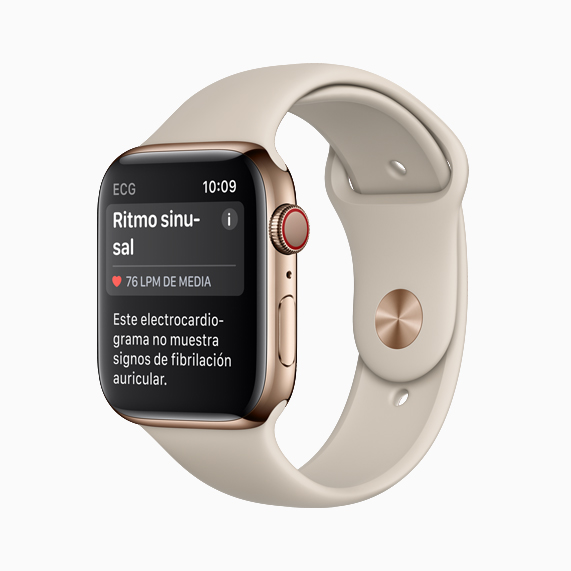UPDATE
March 27, 2019
ECG app and irregular rhythm notification on Apple Watch available today across Europe and Hong Kong
The ECG app on Apple Watch Series 4, a direct-to-consumer product that enables customers to take an electrocardiogram right from their wrist, is available in Hong Kong and 19 European countries, including France, Germany, Italy, Spain and the United Kingdom. In addition to receiving De Novo clearance in the US from the FDA, the ECG app1 and irregular rhythm notification2 are now CE marked and cleared in the European Economic Area.
Part of the free watchOS 5.2 software update, the ECG app can capture heart rhythm on demand in a moment when users experience symptoms such as a rapid or skipped heart beat and help provide clinically important data to physicians. The irregular rhythm notification feature on Apple Watch occasionally checks heart rhythm in the background and sends a notification if an irregular heart rhythm that appears to be atrial fibrillation (AFib) is identified.
The ECG app and irregular rhythm notification feature can alert users to signs of AFib. Left untreated, AFib is one of the leading conditions that can result in stroke, the second most common cause of death around the world.
“We’ve seen the ECG app and irregular rhythm notifications on Apple Watch have meaningful impact on our customers across the United States,” said Jeff Williams, Apple’s chief operating officer. “We are excited to bring these features to customers in Europe and Hong Kong, giving them access to empowering information about their heart health.”
ECG App
New electrodes built into the back crystal and Digital Crown on Apple Watch Series 4 work together with the ECG app to enable customers to take an ECG similar to a single-lead electrocardiogram. Taking an ECG recording is as simple as launching the ECG app on Apple Watch Series 4 and touching the Digital Crown, which completes the circuit and allows electrical signals across the user’s heart to be measured. After 30 seconds, the ECG app can classify the user’s heart rhythm as AFib or sinus rhythm.
All recordings, their associated classifications and any noted symptoms are stored securely in the Health app on iPhone, from which users can share a PDF of the results with physicians.
A clinical trial of around 600 participants found the ECG app on Apple Watch demonstrated 98.3 percent sensitivity in classifying AFib and 99.6 percent specificity in classifying sinus rhythm in classifiable recordings when compared to a gold standard 12-lead ECG administered by a cardiologist. 87.8 percent of recordings in the study could be classified by the ECG app.
Irregular Rhythm Notification
Available on Apple Watch Series 1 or later, the irregular rhythm notification feature will occasionally check the user’s heart rhythm in the background for signs of an irregular heart rhythm using the optical heart sensor. If an irregular rhythm is detected on five rhythm checks over a minimum of 65 minutes, Apple Watch alerts the user with a notification.
The irregular rhythm notification feature was recently studied in the Apple Heart Study. With over 400,000 participants, the Apple Heart Study was the largest screening study on atrial fibrillation ever conducted, and one of the largest cardiovascular trials to date.
Released March 16, 2019, Stanford Medicine’s results from the Apple Heart Study found “only 0.5 percent of participants received irregular pulse notifications, an important finding given concerns about potential over-notification.” The study further found evidence to support wearable technology has the ability to safely identify heart rate irregularities, which subsequent testing confirmed to be atrial fibrillation.
To enable these new heart features, customers will open the Health app on iPhone where they will be presented with details about who can use these features, what the features can and cannot do, what results users may get, how to interpret those results and clear instructions for what to do if users are feeling symptoms that require immediate medical attention.
watchOS 5.2 will be available today. Customers must also update their iPhone to iOS 12.2.
Images of Apple Watch and ECG App
- 1 This feature is available on Apple Watch Series 4 in Austria, Belgium, Denmark, Finland, France, Germany, Greece, Guam, Hong Kong, Hungary, Ireland, Italy, Luxembourg, Netherlands, Norway, Portugal, Puerto Rico, Romania, Spain, Sweden, Switzerland, the UK, US and US Virgin Islands, and requires iPhone 5s or later on iOS 12.2. The ECG app does not detect a heart attack, blood clots, a stroke or other heart-related conditions including high blood pressure, congestive heart failure, high cholesterol or other forms of arrhythmia.
2 This feature is available for Apple Watch Series 1 and later and requires iPhone 5s or later on iOS 12.2 in Austria, Belgium, Denmark, Finland, France, Germany, Greece, Guam, Hong Kong, Hungary, Ireland, Italy, Luxembourg, Netherlands, Norway, Portugal, Puerto Rico, Romania, Spain, Sweden, Switzerland, the UK, US and US Virgin Islands. The irregular rhythm notification feature does not detect a heart attack, blood clots, a stroke or other heart-related conditions including high blood pressure, congestive heart failure, high cholesterol or other forms of arrhythmia.




